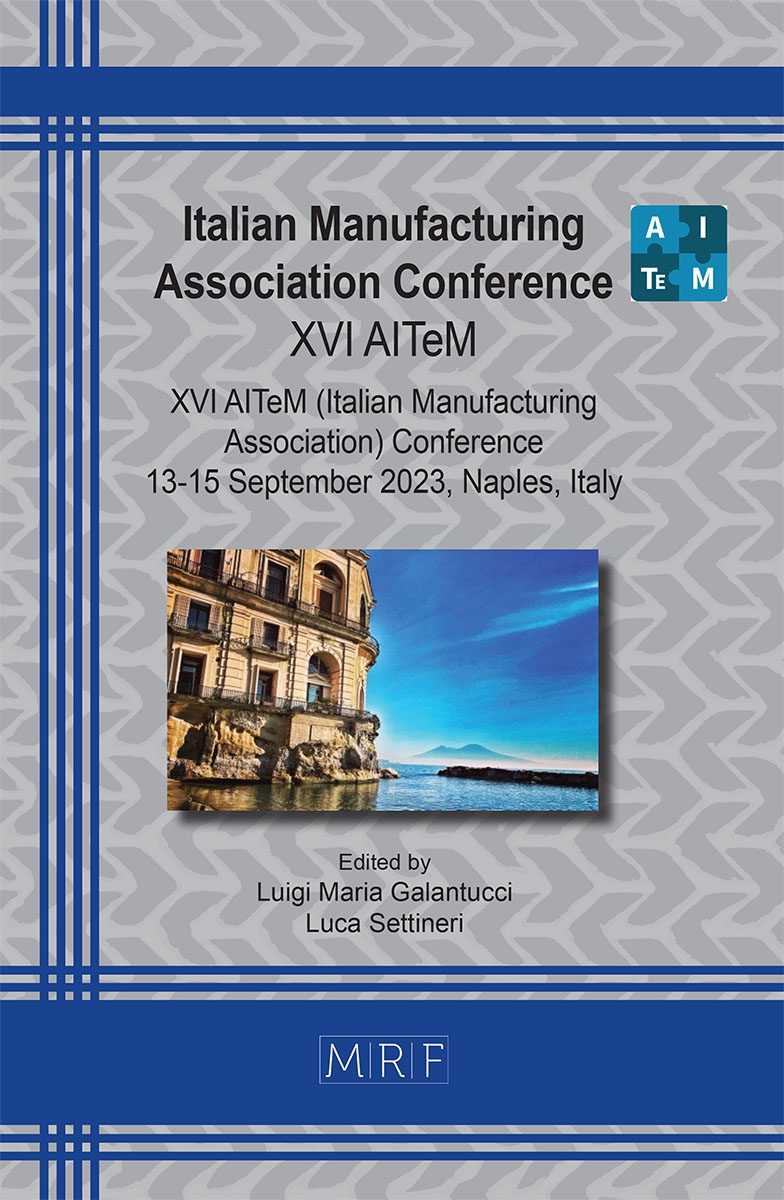Ductility and linear energy density of Ti6Al4V parts produced with additive powder bed fusion technology
Gianluca Buffa, Dina Palmeri, Gaetano Pollara, Livan Fratini, Alessandro Benigno
download PDFAbstract. Hybrid metal forming processes involve the integration of commonly used sheet metal forming processes, as bending, deep drawing and incremental forming, with additive manufacturing processes as Powder Bed Fusion. In recent ybears, these integrations have been more developed for manufacturing sectors characterized by components with complex geometries in low numbers, as the aerospace sector. Hybrid additive manufacturing overcomes the typical limitations of additive manufacturing related to low productivity, metallurgical defects and low dimensional accuracy. In this perspective, a key aspect of hybrid processes is the production of parts characterized by high strength and ductility. In the present work, a study was carried out on the influence of process parameters, such as laser power and scanning speed, on material ductility for Ti6Al4V alloy samples produced by Selective Laser Melting. In particular, the material strength and ductility were related to the process linear energy density (LED).
Keywords
Powder Bed Fusion, Linear Energy Density, Ductility
Published online 9/5/2023, 8 pages
Copyright © 2023 by the author(s)
Published under license by Materials Research Forum LLC., Millersville PA, USA
Citation: Gianluca Buffa, Dina Palmeri, Gaetano Pollara, Livan Fratini, Alessandro Benigno, Ductility and linear energy density of Ti6Al4V parts produced with additive powder bed fusion technology, Materials Research Proceedings, Vol. 35, pp 241-248, 2023
DOI: https://doi.org/10.21741/9781644902714-29
The article was published as article 29 of the book Italian Manufacturing Association Conference
![]() Content from this work may be used under the terms of the Creative Commons Attribution 3.0 license. Any further distribution of this work must maintain attribution to the author(s) and the title of the work, journal citation and DOI.
Content from this work may be used under the terms of the Creative Commons Attribution 3.0 license. Any further distribution of this work must maintain attribution to the author(s) and the title of the work, journal citation and DOI.
References
[1] A. Schaub, B. Ahuja, L. Butzhammer, J. Osterziel, M. Schmidt, and M. Merklein, Additive manufacturing of functional elements on sheet metal, Phys. Procedia, 83 (2016) 797–807. https://doi.org/10.1016/j.phpro.2016.08.082
[2] M. D. Bambach, M. Bambach, A. Sviridov, and S. Weiss, New process chains involving additive manufacturing and metal forming – A chance for saving energy?, Procedia Eng., 207 (2017) 1176–1181. https://doi.org/10.1016/j.proeng.2017.10.1049
[3] J. M. Flynn, A. Shokrani, S. T. Newman, and V. Dhokia, Hybrid additive and subtractive machine tools – Research and industrial developments, Int. J. Mach. Tools Manuf., 101 (2016) 79–101. https://doi.org/10.1016/j.ijmachtools.2015.11.007
[4] M. Hirtler, A. Jedynak, B. Sydow, A. Sviridov, and M. Bambach, A study on the mechanical properties of hybrid parts manufactured by forging and wire arc additive manufacturing, Procedia Manuf., 47 (2020) 1141–1148. https://doi.org/10.1016/j.promfg.2020.04.136
[5] M. Merklein, R. Schulte, and T. Papke, An innovative process combination of additive manufacturing and sheet bulk metal forming for manufacturing a functional hybrid part, J. Mater. Process. Technol., 291 (2021) 117032. https://doi.org/10.1016/j.jmatprotec.2020.117032
[6] M. Bambach, I. Sizova, B. Sydow, S. Hemes, and F. Meiners, Hybrid manufacturing of components from Ti-6Al-4V by metal forming and wire-arc additive manufacturing, J. Mater. Process. Technol., 282 (2020) 116689. https://doi.org/10.1016/j.jmatprotec.2020.116689
[7] T. Pasang et al., Directionally-Dependent Mechanical Properties of Ti6Al4V, Materials (Basel)., 14 (2021) 13:3603, doi: https://doi.org/10.3390/ ma14133603
[8] D. Wang, W. Dou, and Y. Yang, Research on selective laser melting of Ti6Al4V: Surface morphologies, optimized processing zone, and ductility improvement mechanism, Metals (Basel)., 8 (2018) 7:471. https://doi.org/10.3390/met8070471
[9] A. Moridi, A. G. Demir, L. Caprio, A. J. Hart, B. Previtali, and B. M. Colosimo, Deformation and failure mechanisms of Ti–6Al–4V as built by selective laser melting, Mater. Sci. Eng. A, 768 (2019) 0–26. https://doi.org/10.1016/j.msea.2019.138456
[10] J. Liu et al., Achieving Ti6Al4V alloys with both high strength and ductility via selective laser melting, Mater. Sci. Eng. A, 766 (2019) 138319. https://doi.org/10.1016/j.msea.2019.138319
[11] D. Palmeri, G. Buffa, G. Pollara, and L. Fratini, The Effect of Building Direction on Microstructure and Microhardness during Selective Laser Melting of Ti6Al4V Titanium Alloy, J. Mater. Eng. Perform., (2021). https://doi.org/10.1007/s11665-021-06039-x
[12] D. Palmeri, G. Buffa, G. Pollara, and L. Fratini, Sample building orientation effect on porosity and mechanical properties in Selective Laser Melting of Ti6Al4V titanium alloy, Mater. Sci. Eng. A, 830 (2022) 142306. https://doi.org/10.1016/j.msea.2021.142306












